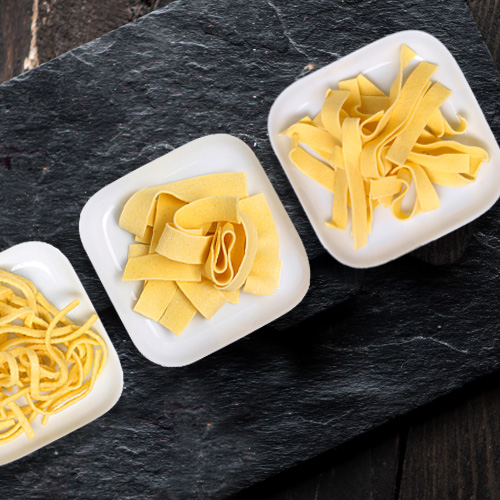
Outstanding product quality and a consistent focus on the needs of our customers have secured our excellent market position.
Im Lossenfeld 17
77731 Willstätt
Phone: +49 (0) 7852-9364-0
E-mail: info@armbruster-teigwaren.de
Monday to Friday, 8.00h – 17.00h
You will find us at Lossenfeld 17 in 77731 Willstätt.
We only use eggs from KAT barn farming. KAT stands for “Kontrolliert Alternative Tierhaltungsformen” (Controlled Alternative Animal Husbandry) – this is a control system to which around 600 rearing farms with around 36 million rearing places and around 2,250 laying farms with around 80 million hen places are affiliated. Further information on KAT can be found on the website www.was-steht-auf-dem-ei.de.
You can contact us at any time at the general contact address info@armbruster-teigwaren.de or directly our quality management staff at qs@armbruster-teigwaren.de
We produce around 70 different shapes: Spätzle, linguine, fusili, shells, cavatappi, …. By shapes, we mean the form that the pasta dough takes. The dough itself can also vary, e.g. consist of durum wheat or spelt semolina and have different egg contents (from zero to 30% egg content).
All you need to do to cook pasta is boil water and then add the pasta to the boiling water. It doesn’t matter when the water is salted. Water that has already been salted has a higher boiling point than unsalted water, so it only boils at a slightly higher temperature. If you add two tablespoons of salt to one liter of water, the boiling point increases to 100.5 degrees Celsius. The cause lies in the ions of sodium chloride table salt: The electrically charged salt ions Na+ and Cl- attract water molecules in the orientation corresponding to the water polarity.
The water molecules are then somewhat more strongly bound and a higher thermal energy is required until the water boils. However, salted water actually heats up more quickly. It therefore takes a little longer to reach boiling temperature. This is hardly noticeable, so it makes no real difference.
However, the amount of salt is important. On the one hand, it is a matter of taste, on the other hand, the basic rule is: 2 grams per liter of cooking water.
We often hear that adding oil to pasta water helps the pasta to stick together less. But firstly, this often doesn’t help, and the oil can also make the pasta less receptive to the sauce later on, because the sauce is less likely to stick to the oily pasta. We therefore believe that oil should not be added to the pasta water. If pasta sticks to the bottom of the pan after cooking or sticks very strongly to each other, then you have probably cooked it in a pan that is too small and/or with too little water. There should be about one liter of water per 100 grams of pasta. Regular stirring also helps to ensure that nothing sticks together.
The variety of different pasta shapes means different cooking times, as well as personal taste, whether you prefer your pasta soft-boiled or more al dente. The cooking time stated on the packaging should therefore be seen rather as a guide. We recommend tasting the pasta about one minute before the specified cooking time has elapsed.
Because if you don’t want to miss the al dente moment, it’s better to try the pasta too early than too late and then decide.
We make the following four recommendations regarding the choice of sauce and pasta shape: Firstly, the amount of pasta and the amount of sauce should be in balance with each other. Too much pasta and too little sauce is just as bad as too much sauce and too little pasta. Secondly, the thicker the sauce, the wider and thicker the noodle. Gorgonzola sauce, for example, does not go well with spaghetti as it is too thick.
Conversely, long thin noodles go better with light and rather liquid sauces. Thirdly, smooth oily sauces need a large surface area – i.e. a thin noodle that is as long as possible in order to adhere as well as possible. The oily garlic sauce Aglio Olio, for example, is perfect with spaghetti. And finally, fourthly, the pasta should take the sauce off the plate. For that case we have for example pasta with cavities or twists such as rigatoni or spirelli for sauces with chunks.
Spaghetti Bolognese does not exist according to this rule, because the bits of Bolognese sauce would remain on the plate. Spirals or rigatoni are more suitable for a Bolognese sauce.
The durum wheat semolina we use comes from durum wheat mills all over Europe. The focus is on mills in Germany, with suppliers from France, Spain, Luxembourg and Italy.